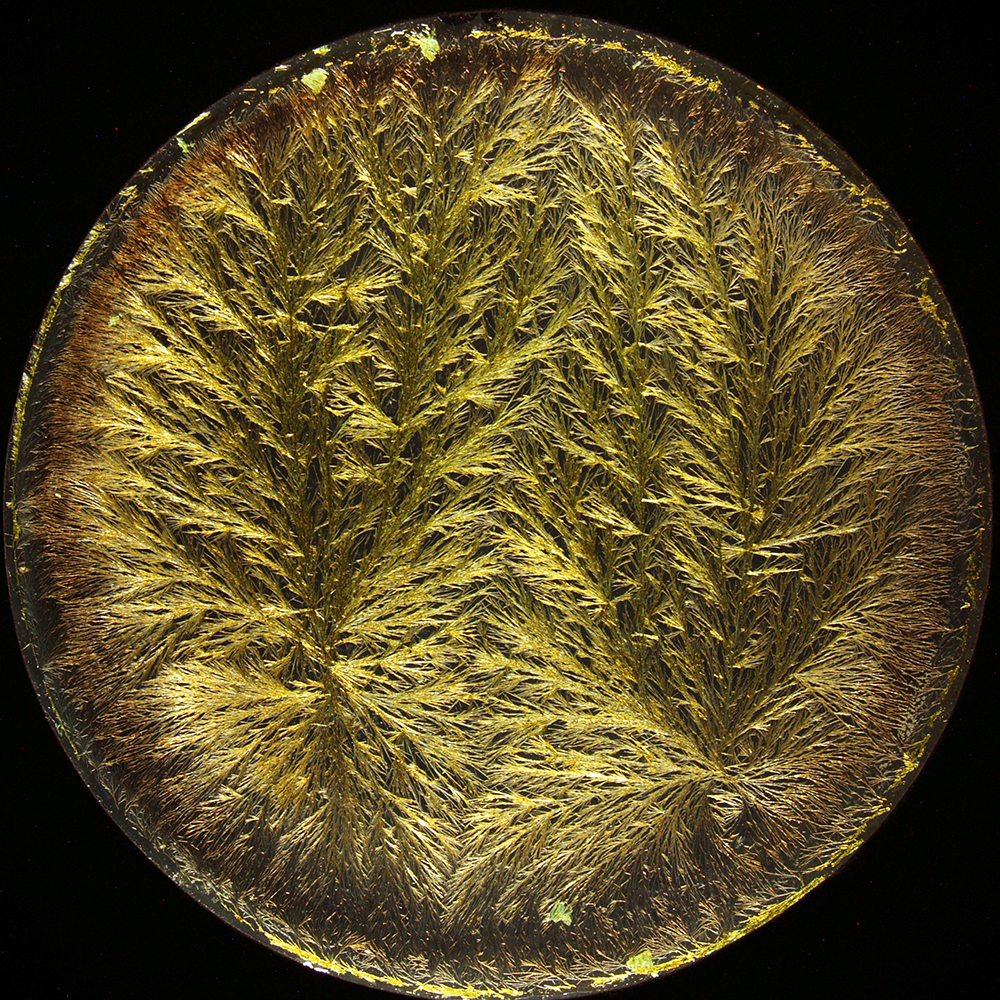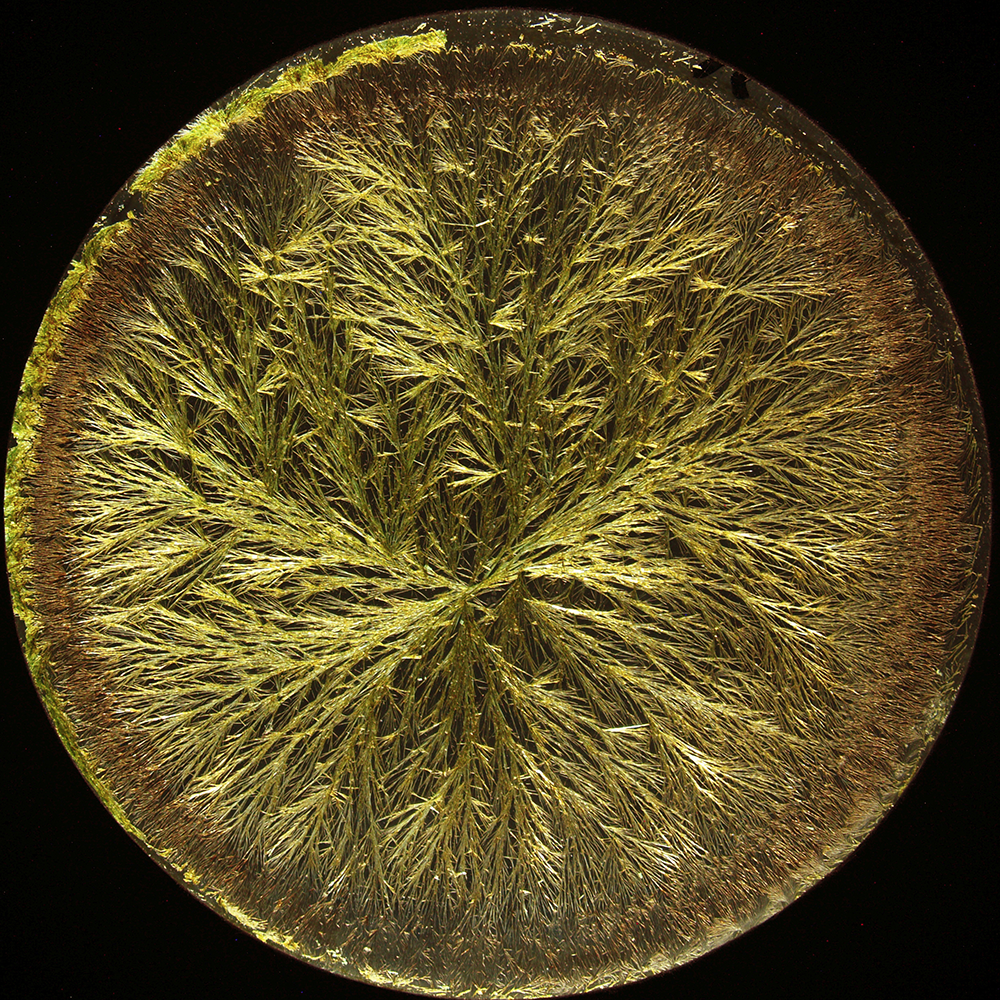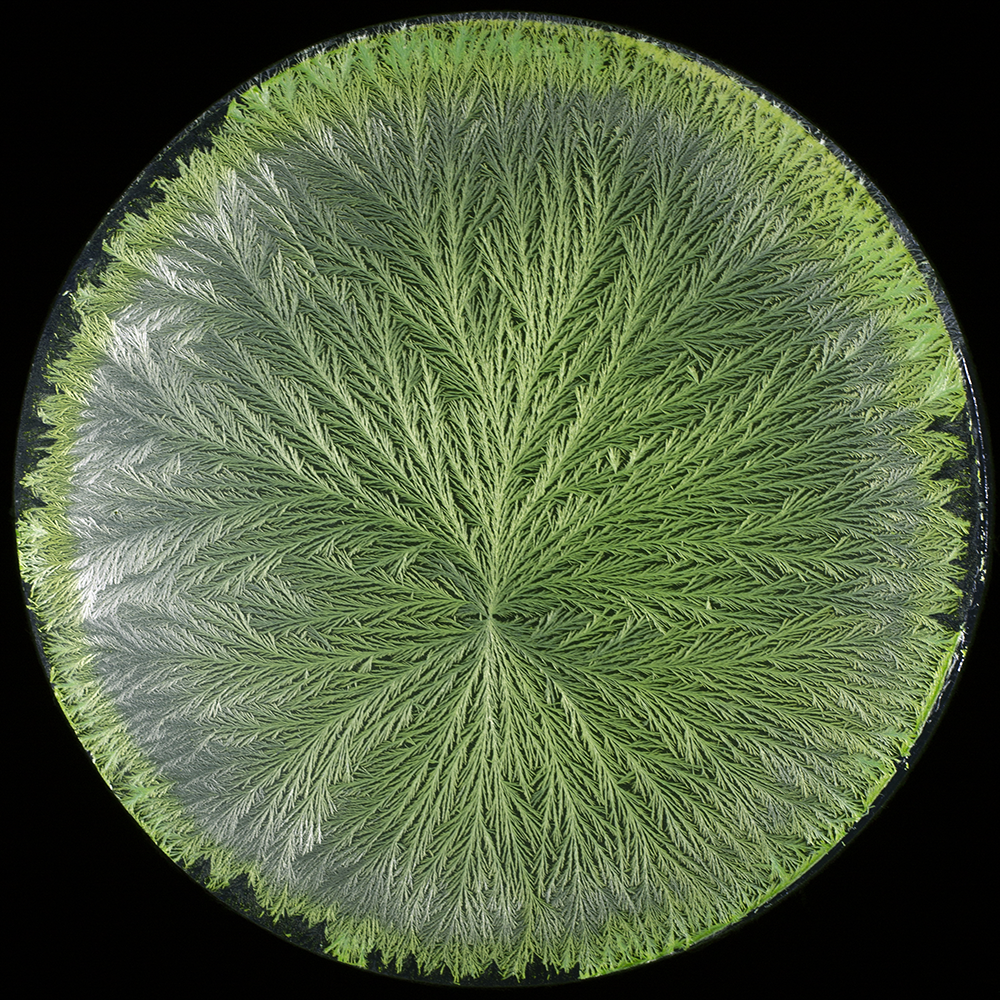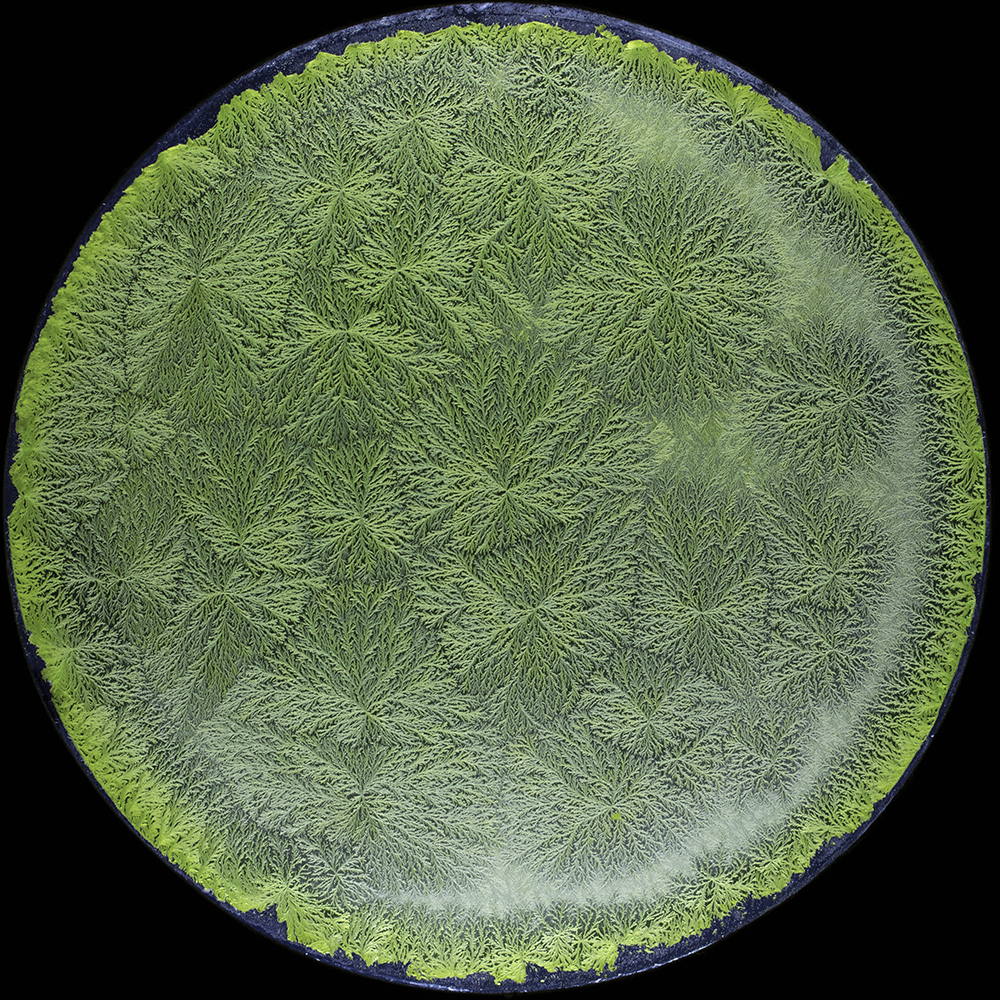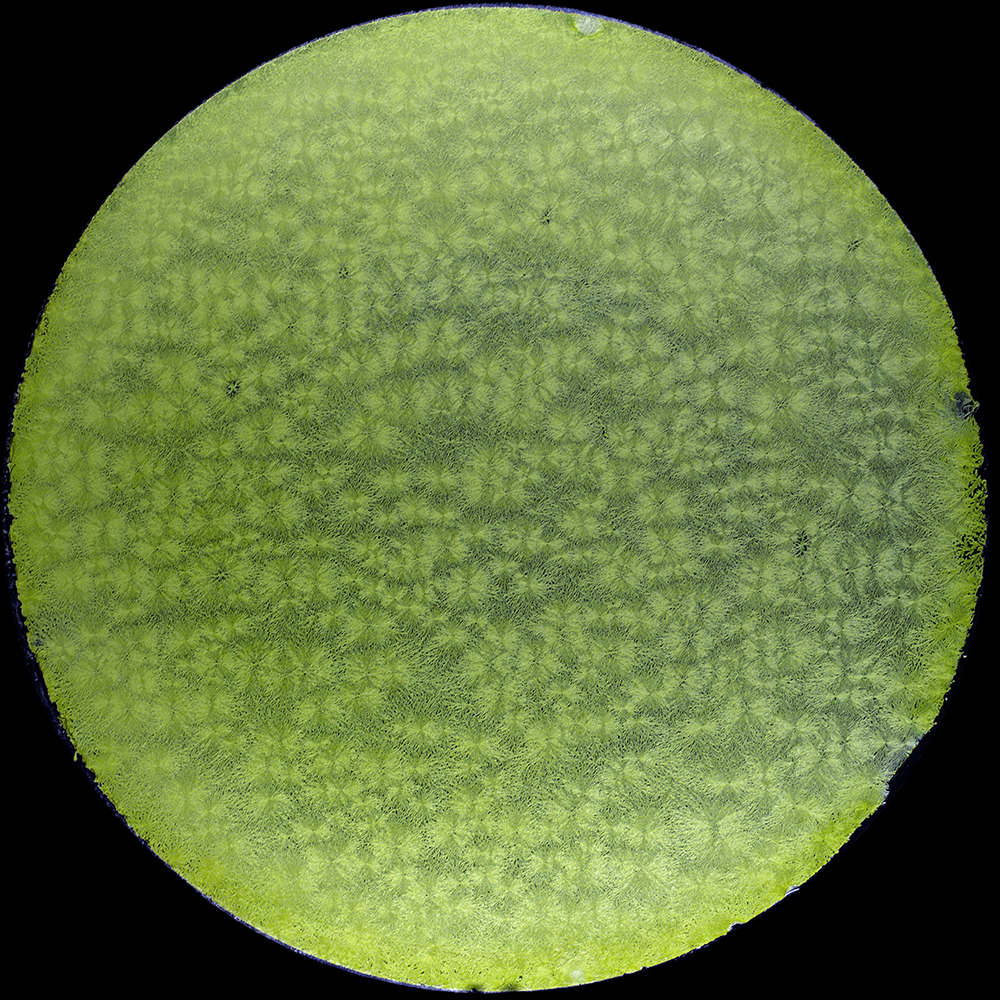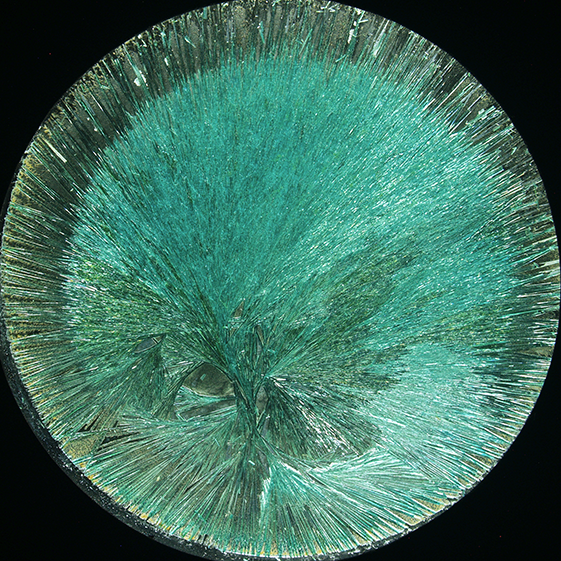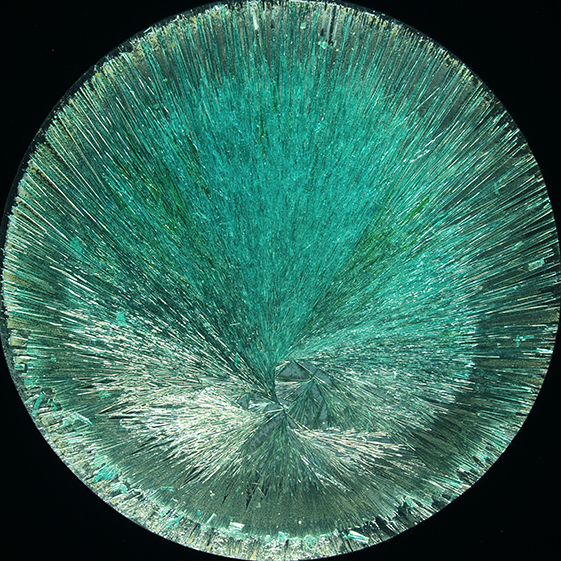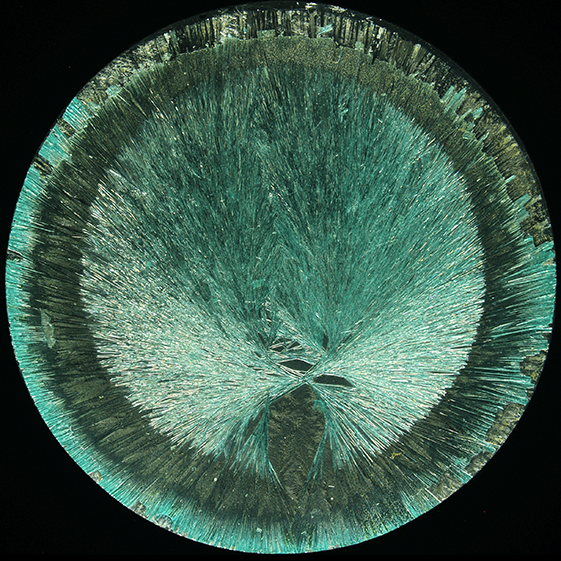Biocrystallisation of Cyanobacteria on 10 cm diameter glass plate
Kin (work in progress, various mediums in collaboration with writer and Human ecologist Line Thastum)
Kin is an ode to empathetic coexistence between all beings. It is a curious exploration of entanglement and kinship that looks at the evolutionary codependence and ancient heritage we carry from bacteria, algae, plants and animals through aeons of deep time. Cyanobacteria, moss, lichen, nettle cod fish and human blood are the six carefully selected bodies that form this web of interwoven connections.
These bodies have all been embodied through the picture forming scientific method called biocrystallisation. A few measured and carefully calculated milliliters of plant juice, decoction, bacterial liquid or other organic substances have been added to an equally carefully calculated solution of copper chloride.
Copper chloride which is deadly toxic to the living organic liquids. Luminous turquoise blue, evergreen, moss green liquids in glass flasks. Distributed on circular glass plates. After hours, in the dark, crystallisations occur, the organic liquids fight against the copper chloride.
Materialise from one or more centers, slowly building up. Beautiful, distinctive crystals. Different for every substance, for every species, every being. Some form unique and powerful images with strong cores; overwhelming the copper chloride’s own crystalline form fully unfolding to the edge of the glass plate. Others form weaker images or more sporadic centers and do not develop in full before they wither.
The crystallisations are an imprint of the unique nature of biological organisms. Biological creatures, liquids and sub-element’s individual identity and resilience. An expression of a shared vitality between everything living, crystallised in one exact moment in time.
Biocrystallisation of Cyanobacteria on 10 cm diameter glass plate
3.5 billion years ago Cyanobacteria, cyan coloured single celled creatures, captured the color, the pigment, the green, the blue, the turquoise. Catching the light in the pigment inventing the photosynthesis, creating oxygen in the sea where they arose. Creating nourishment and the first embryo for more composed beings and greater complexity.
Some of them grew into other organisms, became their chloroplasts and gave them the gift of photosynthesis. Still existing in their original from, cyanobacteria contain life-giving protein and minerals, and have the ability to purify heavy metals and pollution, just as they create deadly toxins when blooming in lakes and oceans saturated with man-made nutrients.
Biocrystallisation of Bryophyta (moss) on 10 cm diameter glass plate
3030 billion years later – 470 million years ago, mosses: Bryophyta, Hepatophyta and Anthocerotophyta as some of the first beings, slowly moved from the ocean to the earth. The earth was barren. Only rocks, only stones, only gravel, sand, wind, rain, light and dark. They had no roots, for there was no soil, their nourishment was light, water and minerals.
With the ability to contain 30 times their own weight of water and with their chloroplasts, they created organic matter and oxygen for the roots of plants and the lungs of animals. They developed a reproductive system for others to follow, with mobile sperm cells in sac-shaped antheridia and vase-shaped archegonia each with one egg - so equal to the female uterus.
Biocrystallisation of Lichen on 10 cm diameter glass plate
Lichen is also a lifeform; a creature that developed from the ocean to the earth about 400 million years ago. A symbiotic organism. Neither plant nor animal. A fungus that embraces an algae or cyanobacteria that converts nitrogen and light into nourishment for both entangled bodies. In return the fungus creates a protective microclimate in its beautiful shaped thallus.
Biocrystallisation of Lichen on 10 cm diameter glass plate
It is an infinitely slow, almost immortal being with individuals up to 5,000 years old. A creature that can live on the edge, in cold and heat, on rocks, in deserts and extreme heights. Desiccated for years, it can be resurrected by the water flowing from its origin like time. Only mans accelerating changes of the world and the space we occupy it cannot survive.
Kin also holds a poetic narrative exploring the means of language to bridge between the rational and the sensuous. This narrative stems from an exploration of the intergenerational kinship between mother and daughter, as well as that which we share with our more-than-human kin. The writing serves as a bloodline running through the center of the project serving as an intuitive narrative guiding the viewer into the world of entangled coexistence.
Biocrystallisation of Urtica Dioca (Stinging nettle) on 10 cm diameter glass plate
The origin of the large nettle, Netla - the old Nordic word for weaving, dates back to the emergence of flower plants 144 million years ago. It is widespread and likes to follow humans to absorb the nutrients we waste and disperse while living our human lives. It follows us and offers to give back the energy in forms of the minerals, vitamins and the protein it contains.
Urðr, Skuld & Verðandi
Nettle braid robe made from nettle fibre, length 8 m
Key minerals from the sea; iron, potassium, manganese, calcium and phosphorus, that flow in our blood and build up our bones, Netla offers to us as well as fibers to weave canvas and rope, and leaves to dye wool, and to make extracts fertilizing the soil. Leaves that also serve as nutrition for butterfly larvae of beautiful species such as Peacock and Red Admiral.
Biocrystalisation of Urtica dioica (Stinging nettle seeds) on 10 cm diameter glass plate
“Skin graft” Gadus morhua (Cod fish)
Colour photograph, 40 x 60 cm
Like the water flow lifegiving through Moss and Lichen, it is the entire element of the Cod Fish, Gadus morhua. 380 million years ago, these gelled water creatures emerged and evolved. A fierce and yet vulnerable predator whose eggs can only hatch in water with a specific concentration of oxygen, salt and temperature. Vulnerable as temperatures change and oceans acidify.
The growth of a biocrystallisation - Gadus morhua (Cod fish).
Original length 14 hours.
Vulnerable as trawls and sonars has reduced the population by nearly 90 % in 40 years. And yet a nutritious and healing gift to humans. With the ability to grow together with human tissue, it offers its skin as graft. Healing severe trauma, its cells embroil themselves together with ours, with essential properties of oils, collagen and vitality from the ocean; our common origin.
Biocrystallisation of Gadus morhua (cod fish) on 10 cm diameter glass plate
The sea flushes through our veins like plasma, salt-saturated like the ocean. Connect billions of individually and collectively working cells, cohesive organisms entangled within us. Erythrocytes, leukocytes and white blood cells, proteins, minerals, hormones, vitamins, billions of bacteria and fungi. Connects us with cyanobacteria, moss, lichens cod and nettles - and with each other.
Biocrystallisation of homo sapiens blood (from the artist and her mother) on glass plate, 10 cm diameter
300,000 years ago, the human species arose. Less than a ten thousandths of the time the cyanobacteria have been on Earth. So young we are, so inexperienced and yet so complex; we have genetic knowledge from all the beings that paved the evolutionary path for us. Collective subconscious of community and cohesion.









